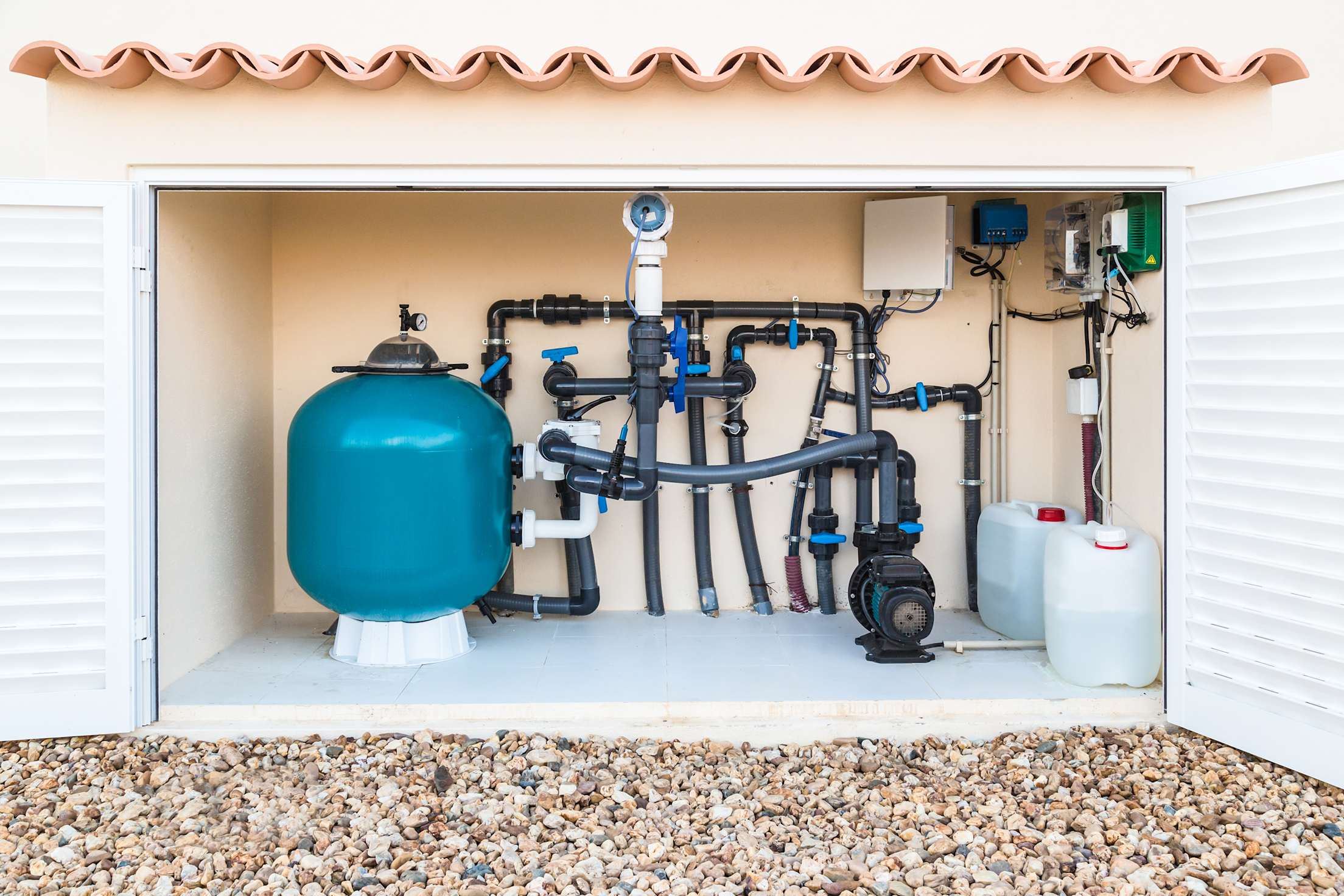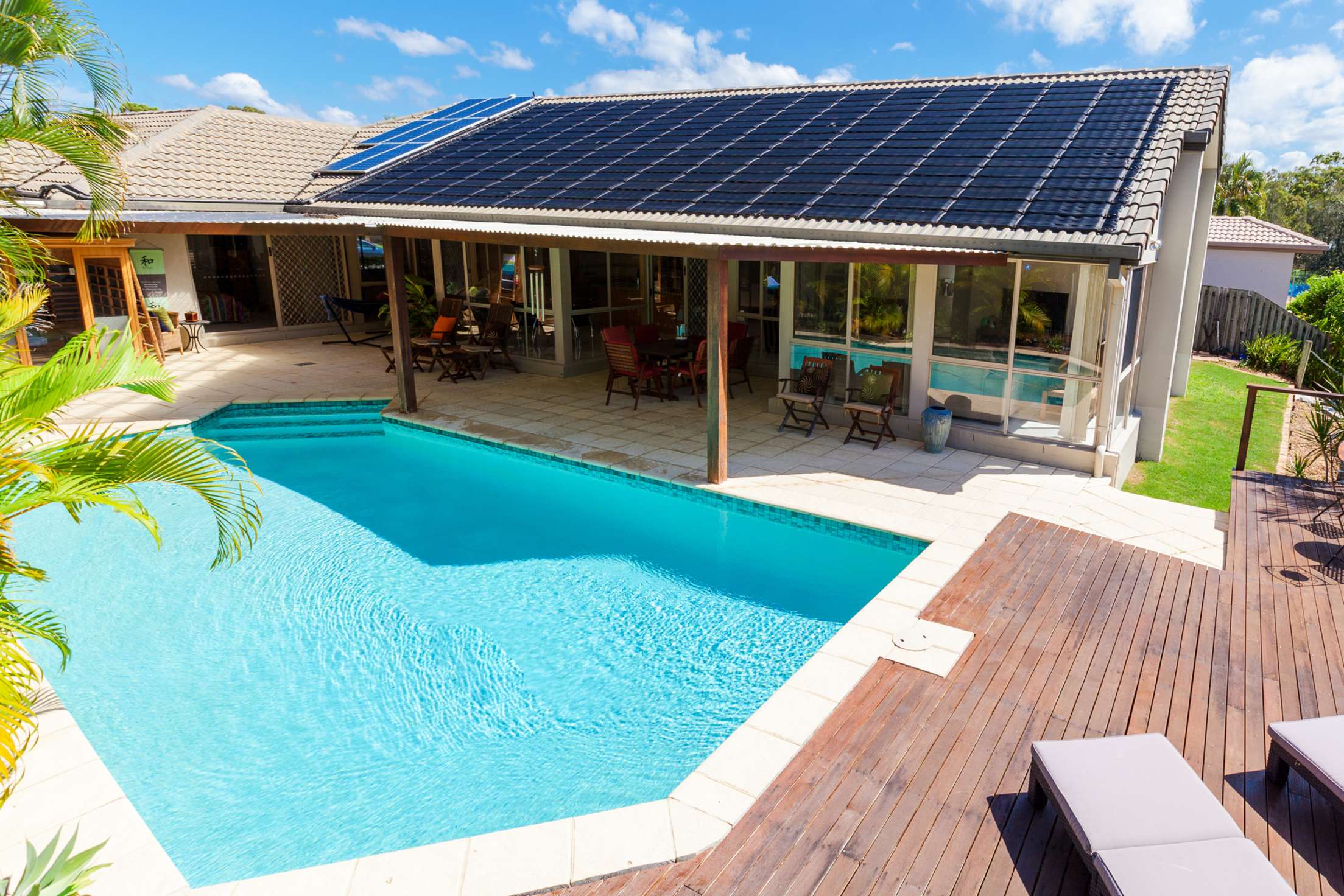
8 Tips to Make Your Pool More Efficient
Save energy, water, and chemicals while keeping your swimming pool clean and inviting.

A refreshing swim is essential for summer fun—and for surviving searing temps. But your backyard oasis may be soaking up your energy budget and money. Luckily, there are several ways to save energy, water, and chemicals for a backyard pool. Let’s dive in.
Cover up.
The average annual cost of heating an uncovered pool to 80 degrees in Phoenix is $875, according to the U.S. Department of Energy. Add a cover, and that cost plunges to $85. That’s because evaporation causes 70 percent of a pool’s energy loss. “Evaporation loss can be significant in a hot, dry climate, and our desert surrounds create a lot of airborne dirt that ends up in the pool,” notes Kim Elliott, program representative at Salt River Project, an Arizona utilities company.
Covering your pool reduces energy waste, water consumption, chemical use, and cleaning time. It also adds an extra layer of safety to prevent children or animals from drowning. The Department of Energy recommends either bubble (a.k.a. solar) or vinyl covers. Bubble covers are reasonably priced and transparent, so they naturally warm your pool, but they wear out quickly in sun-drenched areas. Vinyl covers are more expensive, but they last longer and reduce solar energy absorption by 20 to 40 percent, so they may be preferable in hotter locales.
Don’t forget to cover your equipment. “Pool owners can add years of life to pumps, valves, and filters by shading them since most components are plastic or fiberglass, which degrades in UV light,” Elliott adds.

Choose the new wave of pool pumps.
After your air-conditioner, your home’s biggest energy user could be your pool pump. Conventional pumps run at only one speed, and that rate is faster than necessary, according to the Environmental Protection Agency. An old-school machine can cost you up to $720 in energy every year.
Energy Star-certified variable speed pumps run at adjustable speeds, which can translate into huge energy savings. For example, decreasing the speed by half allows the pump to expend one-eighth as much energy. These efficient pumps can save you $2,900 over their lifetime and cut 2.2 tons of greenhouse gas emissions per year (which is equivalent to the emissions released from an average car driving 5,016 miles). To trim even more energy, run your pump less frequently. Experts recommend eight to 12 hours during summer and six to eight hours in winter.
Upgrade your filter.
While filters themselves aren’t energy hogs, an inefficient or dirty filter forces your pump to work harder, and that does drain energy. If you have a sand or diatomaceous earth (DE) filter, switch to a cartridge filter. They’re easier on your pump and clean the pool faster. For maximum efficiency, choose a bigger filter with more surface area to strain the water. Clean your filter regularly, and replace it at the time interval suggested by the manufacturer.

Color coordinate to your climate.
Just as wearing a white or black t-shirt makes you cooler or hotter, the color of your pool impacts the water temperature. Dark finishes like cobalt or pebble gray absorb heat from the sun and naturally warm the water, which can save you energy, particularly if you heat the pool in cooler seasons. On the other hand, if your home is in the hot desert, classic robin’s egg blue will better reflect the rays and help keep your pool comfortably cool. The same color rules apply to your pool cover.
Dial down the temp.
If you won’t be using your pool for a few days, turn the temperature down or switch the heater off. While you may have heard that you expend more energy to heat the pool back up than you save by temporarily reducing the temperature, it's a myth, according to the EPA.

Splash out on solar.
With costs plummeting, solar pool heaters have become an affordable and eco-friendly option. And in hotter temps, they can even be used to cool the pool overnight. Solar heaters pay for themselves in 1.5 to seven years, thanks to their efficiency and low operating costs. Plus, they last longer than their gas and heat pump counterparts.
Recycle your water.
As your pool evaporates, the minerals in the water and chlorine tablets become concentrated, so every two or three years, many people drain and refill their pool. But there’s a problem with that method, says Chad Nikkel, former president of Aquaman Pools in Scottsdale. “If you drain a pool, there’s 15,000 gallons of water down the sewer. We live in a desert. We’re trying to conserve water,” he says. “The solution, in my opinion, is mobile reverse osmosis.” Companies like Aquaman pump your water through a portable purification system and return it to the pool cleaned of contaminants and excess minerals.
The process typically costs around $800, which is roughly $300 more than the cost of replacing the water and the chemicals, according to Nikkel. But because the water returned to the pool after the reverse osmosis process is so well filtered, it requires fewer chemicals to keep it safe and clear.
Cut back on chemicals.
Chlorine kills bacteria, but these die-hard microbes can protect themselves by forming a slimy biofilm that absorbs chemicals. So you’ll need to constantly increase the dose of disinfectants to clean your pool. What’s more, the manufacture of chlorine causes mercury buildup in Earth’s air and water. To reduce chlorine use, consider a saltwater pool or a sphagnum moss treatment system. Alternatively, go chemical-free with a natural pool complete with lily pads, reeds, and other plants that purify the water.